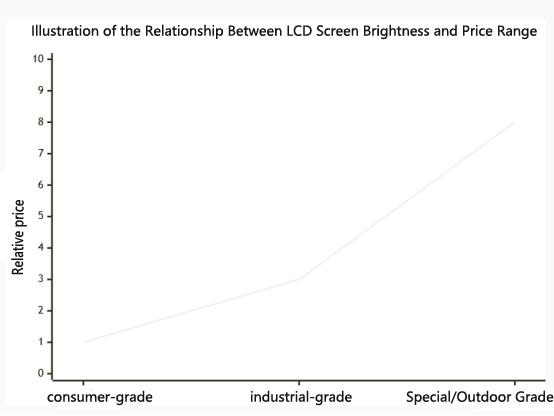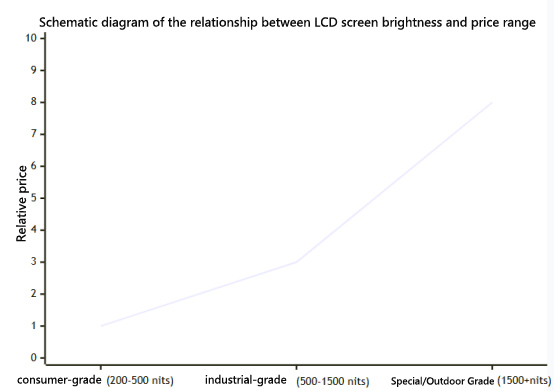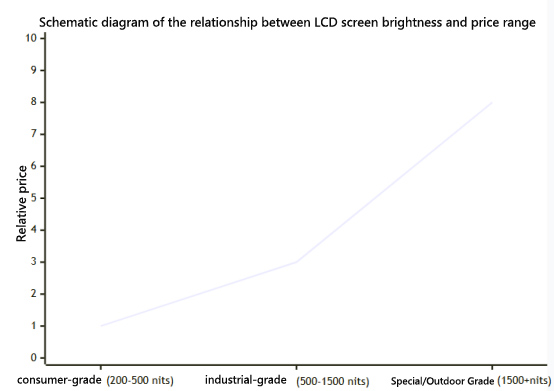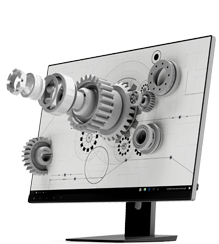Why is the price of high brightness LCD screens so "unattainable"?

In the selection process of LCD screens, brightness is one of the most significant factors leading to price differences The price difference between a regular screen with a few hundred nits and a high brightness screen with thousands of nits can be sever
Abstract: In the selection process of LCD screens, brightness is one of the most significant factors leading to price differences. The price difference between a regular screen with a few hundred nits and a high brightness screen with thousands of nits can be several times or even dozens of times. This article will delve into why "brighter" directly means "more expensive", revealing the technical challenges and cost drivers behind it.
Introduction: The "J-shaped Curve" of Brightness and Price
The relationship between the price and brightness of LCD screens is not simply a linear increase, but a steep "J-shaped curve". When the brightness requirement exceeds the conventional consumer level, the cost increase will be significantly amplified for every 100 nits increase in brightness. Behind this is a cost upgrade driven by materials science, thermodynamics, and electronic engineering.
I. Core cost drivers
The cost increase caused by high brightness is systematic, mainly reflected in the following aspects:
1. The exponential growth of light source costs
Quantity doubling: The most direct way to achieve higher brightness is to increase the number of LED beads. A 500nits screen may require dozens of LEDs, while a 1500nits screen requires hundreds. The increase in the number of lamp beads directly leads to an increase in material costs.
Quality leap: High brightness screens cannot be simply stacked with ordinary LEDs. It must use high-quality, high-efficiency industrial grade LED chips. These chips can operate at higher driving currents and maintain lower light attenuation, and their unit price is much higher than that of consumer grade LEDs.
The trap of "yield rate": Among hundreds of LEDs, if one LED is inconsistent in color or brightness, it will cause serious "mura" or color difference on the screen, and the entire module may be scrapped as a result, which invisibly increases production costs.
2. Complexity of thermal management system
Physical law: Higher brightness means higher electrical power input, and most of the energy will be converted into heat. Heat is the "number one killer" of LED lifespan.
Cooling cost: Ordinary screens may rely solely on plastic frames and air cooling. And high brightness screens must introduce metal heat sinks, Heat Pipes, and even active cooling fans. These additional heat dissipation structures not only increase material costs, but also greatly increase the complexity of structural design and assembly.
3. Upgrade of optical film
Efficiency first: The light emitted by the backlight needs to be efficiently utilized. In order to concentrate limited light energy more towards the front view, a higher level brightening film must be used for the high brightness screen.
Weather resistance requirements: High brightness is usually accompanied by high heat, and optical films must be able to withstand long-term high temperatures without yellowing or deformation. This requires the use of high-quality film materials that are resistant to high temperatures, which are much more expensive than ordinary films.
4. Enhancement of power supply and driving circuit
A stronger heart ": driving hundreds of high-power LEDs requires a more powerful, stable, and efficient power management system. The capacitors, inductors, driver ICs, and other components of this system require higher specifications, which naturally increases the cost.
Stability cost: Industrial and outdoor applications require 7x24 hours of uninterrupted operation, which places extremely strict demands on the stability and lifespan of power circuits. This requires the use of more expensive components and more complex circuit designs to ensure.
II. Price Range and Technical Positioning
For a more intuitive understanding, we can divide LCD screens into three price tiers based on brightness:


1. Consumer Tier (200-500 nits)
Price: Basic, popularized.
Positioning: Pursuing ultimate cost control and economies of scale, used for mobile phones, televisions, and ordinary displays. Brightness is the product of compromise.
2. Industrial/Commercial Tier (500-1500 nits)
Price: 2-5 times that of consumer grade.
Positioning: Balancing cost and performance. In this range, brightness, lifespan, and stability are equally valued. Used for medical diagnosis, industrial HMI, indoor digital signage, etc.
3. Special/Outdoor Tier (1500 nits or more)
Price: 5-20 times or even higher than consumer grade.
Positioning: Performance first, cost second. Each component is specially selected to resist strong light and high temperature, with low output and high degree of customization, belonging to the field of "cost free".
III. Practical advice for purchasers and engineers
Avoiding performance waste: Accurately evaluate the usage environment of your device. A device that is only used in indoor offices and uses a 1000nits screen is purely wasteful and will be directly reflected in the overall cost.
Pay attention to total cost of ownership: High brightness screens not only have high procurement costs, but their power consumption and potential cooling needs (such as fans) will also increase subsequent operating costs.
Understanding "life cost": For industrial projects that require a long lifespan, choosing a screen with sufficient brightness and excellent heat dissipation design in the early stage, although the unit price is high, can avoid frequent replacement due to premature backlight decay, which is more economical in the long run.
Seeking professional advice: Have in-depth communication with the technical sales team of the display screen supplier to provide you with specific application scenarios. They can recommend the most balanced model in terms of brightness, lifespan, and price for you.
Conclusion
There is a gap drawn by the laws of physics and market positioning between the brightness and price of LCD screens. Higher brightness means that manufacturers need to invest more expensive materials, more precise designs, and more complex processes to 'counteract natural laws'. Understanding the principle of "clear pricing" can help you clear the fog of price, no longer simply thinking that high brightness screens are "profitable", but based on the true technical value and lifecycle cost, making the most smart and sustainable choices for your products.










